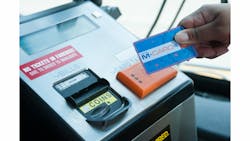When the Milwaukee County Transit System needed to upgrade its nearly 30-year-old fare collection system, leaders there knew it was time to look at finding some new ways for riders to pay.
Dan Boehm, managing director for MCTS, said the system was issuing paper tickets and flash passes to riders, but the availability of smart card readers and technology made the upgrade enticing, so MCTS chose Scheidt & Bachmann to install a system into Milwaukee buses. And in October, riders were introduced to the new MCard.
“I think the biggest challenge is the project time,” Boehm said. “To go from concept to the final rollout takes years. We’ve seen that with other fare systems and we’ve experienced that ourselves.
“It’s a big challenge. It takes a lot of time and staff resources.”
Transit agencies across North America are upgrading their fare collection equipment, but a slew of options can make it overwhelming on deciding which route to take. Some agencies are opting for smart cards, while others are adding mobile ticketing options.
Other systems like the Chicago Transit Authority and Southeastern Pennsylvania Transportation Authority took another path and opted for full open fare payment systems. Across the Atlantic, Transport for London took its upgrades another step further by eliminating cash payments in summer.
Boehm said MCTS decided smart card technology was established enough to move forward on it, but when the agency began planning upgrades open fare payment systems were still being piloted, so it wasn’t an option leaders there were willing to pursue.
“We weren’t comfortable with cellular connections being fast enough or reliable enough, so we decided to go with the card based system,” he said.
In 2015, the Washington Metropolitan Area Transportation Authority (Metro) will start a pilot program to introduce an open fare payment system for riders.
“WMATA’s pilot is a big advance in transit fare payments and for payments in general,” said Randy Vanderhoof, executive director of the Smart Card Alliance. “The open payment platform provides more convenience for riders, allowing them to skip the lines at the ticket vending machine and use any contactless form of payment already existing in their wallets or mobile phones.
“This pilot shows the progress Washington, D.C. is making progress towards a common infrastructure built on compatible contactless cards and mobile devices that government employees and area residents are already carrying. While retail and transit industries are making strides in EMV, contactless and NFC mobile payments, the government market is using the same contactless standards for securing its buildings and information networks.”
Mobile Payment Growth Continues
Smart phone technology and increasing availability in NFC-enabled devices has ushered in ticketing options for transit agencies, which can keep investments in new equipment on a much lower level due to the investment mostly coming from the rider side.
Currently only a small amount of riders are using mobile ticketing options in transit agencies, but Vanderhoof said he expects that number to grow now that Apple has introduced its own NFC fare payment.
According to a study released by Accenture on Oct. 29, the number of North American consumers who used a mobile phone to pay for something is at 40 percent in 2012, up from 16 percent in 2012. About 52 percent of Millennials used a phone for payment and 55 percent of high-income consumers.
Michael Gray, chief technology officer with GlobeSherpa, said transit agencies want to ensure the collection of every revenue dollar it can with fare collection. With the use of mobile ticketing on systems it allows agencies to collect on fares with less infrastructure needs.
“Not only does the rider have these devices, but they’re always changing them and upgrading to the new ios or the new Android,” Gray said. “The system always has to work and you’re always having to keep up with these changes with some sort of software system and to update your systems to meet these changes. This has been an education point with agencies interesting in this technology, so there is a learning process.”
Gray said the advent of technology also turns mobile payment providers like GlobeSherpa in consulting roles for transit agencies to educate them about what technology is available and how to roll it out in the system. It’s vital to improving the agency’s performance because Gray said rider behavior can be tracked at a whole new level with mobile payment systems.
“Today we’re used to saying to someone ‘sure, you can use my location,’ and there you’re able to see the behavior of the riders,” he said. “For example, we can find out where did someone purchase a ticket…so the next logical step is where did they activate that ticket, where did they click to begin their journey and see that behavior.
“All of a sudden, they have this data right in front of them to really look at ride behavior then ask what does that data tell me from an efficiency angle, how can it be construed from a productivity angel and to ask questions of that data.”
Fare Systems Open Up
Vanderhoof said transit agencies are forced into selling fare media and collecting payment with traditional forms of closed payment systems even though they’re in the business of moving riders quickly and efficiently, not being a financial system. Collecting fare payment with a closed system can be expensive given it has to be managed and maintained in house, but open fare payment systems take that burden off of the agencies.
“What’s now appealing in this technology shift enables transit agencies to concentrate on operations while the fare payments are handled by the financial institutions that are already serving those customers,” Vanderhoof said. “For consumers, this also means they don’t have to stop at a booth or vending machine to convert currency into another currency that’s only accepted in the transit system.”
Vanderhoof said the banking industry uses different technology than that of fare media used by transit operators, so the switch to an open fare payment system means upgrades to a lot of equipment. The agency has to put in card readers capable of reading all different credit cards and debit cards, and mobile devices. Supporting these devices also means back end upgrades to the system and an investment in turnstiles, vending machines, validators and even parking facilities to make sure it’s all compatible with the new fare payment system.
“A new development is that this upgrade is very expensive, but since we’ve seen major transit agencies like Chicago, Philadelphia, Washington, D.C., L.A. and others have gone through the implementation phase and are now in operations with that technology, the cost of that technology is dropping significantly,” Vanderhoof said.
Vanderhoof said new technology is addressing issues with transaction speeds as well. The transportation industry required fare date be processed extremely fast, but changes in improvements in the chip design of payment cards in recent years is addressing this issue.
With payment data theft reported on large scales in the past year from large North American retailers, some riders and agencies may be concerned with security on an open fare payment system. Vanderhoof said there aren’t any issues with security when moving to open fare payment.
“Consumers have a lot of protection when it comes to security when using bank cards. More protection than they may have in the fare media provided by most transit agencies, so first of all, the payment systems do a really good job of making payment technology secure and back up that security with consumers with no liability to them if there’s a breach or the card is stolen or used without their approval,” Vanderhoof said. “So really it’s an enhancement of security for consumers because it follows industry standards for payments, more so than for the closed loop proprietary ones.”
Open fare payment technology continues to evolve, Vanderhoof said. One area being looked at is having the fare calculation and management of the customers’ payments being handled in the back end of the system rather than at the card or the turnstile. By having information stored in the cloud, it allows for multiple ways to use a fare system and a more efficient way of collecting fare payment.
In Washington, D.C., Vanderhoof said the large amount of federal employees riding Metro have government ID cards using compatible technology, which means they could be used as a form of fare payment media.
“People have really been interested in this concept,” Vanderhoof said.
Boehm said MCTS will continue to roll out the new MCard system to riders, install ticket vending machines and work to educate the community about the change and how it will benefit them. Agency staff has done public outreach events about the change and offer a dedicated phone line to help customers with questions about the switch.
And while the MCard is just getting rolled out in Milwaukee, MCTS could see it develop into a powerful tool in attracting new riders and enhancing the rider experience.
“We’ve certainly hear a lot about the rollout of smart card-based systems and they always tend to be very positive for a transit system, so we’re expecting that type of effect,” Boehm said. “Those other transit agencies hive you percentages on how it impacted their system, but we’re going to wait and see what this means for us.”

Joe Petrie | Associate Editor
I came to Mass Transit in 2013 after spending seven years on the daily newsbeat in southeastern Wisconsin.
Based in Milwaukee, I worked as a daily newspaper reporter with the Waukesha Freeman from 2006-2011, where I covered education, county and state government. I went on to cover courts for Patch.com, where I was the main courts reporter in the Metro Milwaukee cluster of websites.
I’ve won multiple awards during the course of my career and have covered some of the biggest political events in the past decade and have appeared on national programs.
Having covered local government and social issues, I discovered the importance of transit and the impact it can have on communities when implemented, supported and funded.






